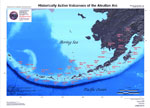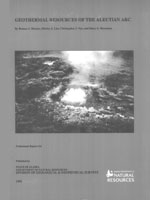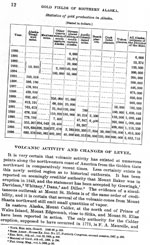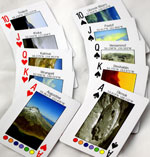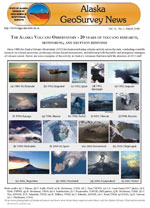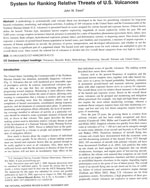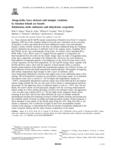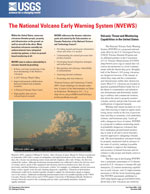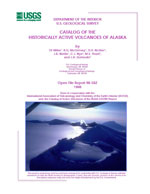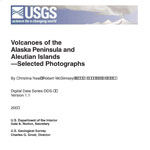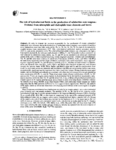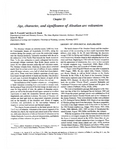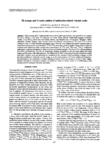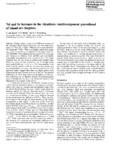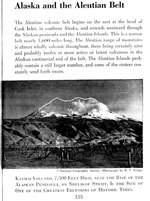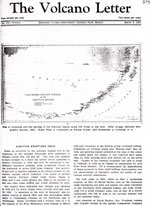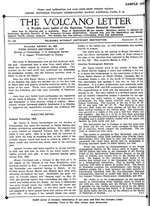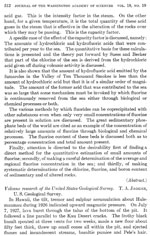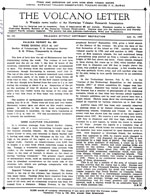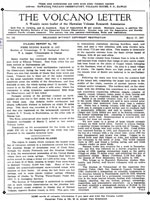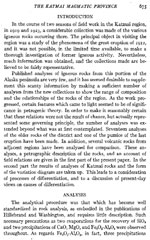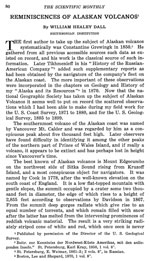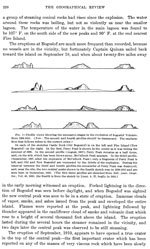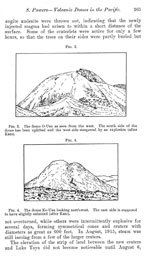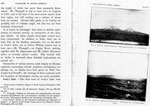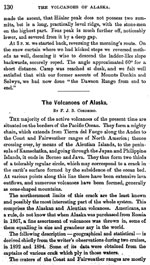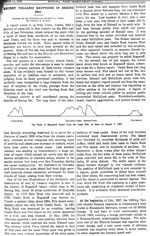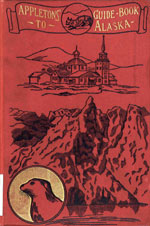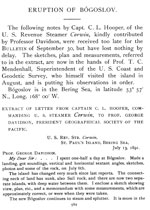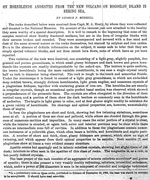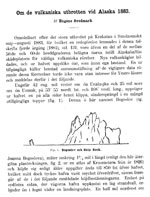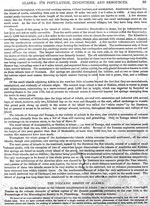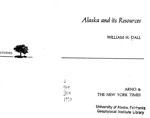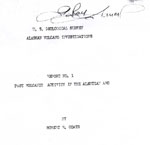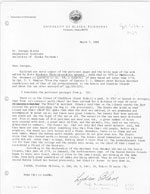References
Saunders-Schultz, P., Lopez, T., Dietterich, H., and Girona, T., 2024, Automatic identification and quantification of volcanic hotspots in Alaska using HotLINK - the hotspot learning and identification network: Frontiers in Earth Science v. 12, 1345104. https://doi.org/10.3389/feart.2024.1345104
Sanders-Schultz, P., 2024, Deep learning detection and quantification of volcanic thermal signals in infrared satellite data: Fairbanks, Alaska, University of Alaska Fairbanks, M.S. thesis, 64 p.
Coombs, M.L., Cameron, C.E., Dietterich, H.R., Boyce, E.S., Wech, A.G., Grapenthin, R., Wallace, K.L., Parker, T., Lopez, T., Crass, S., Fee, D., Haney, M.M., Ketner, D., Loewen, M.W., Lyons, J.J., Nakai, J.S., Power, J.A., Botnick, S., Brewster, I., Enders, M.L., Harmon, D., Kelly, P.J., and Randall, M., 2024, From field station to forecast: managing data at the Alaska Volcano Observatory: Bulletin of Volcanology v. 86, 79. https://doi.org/10.1007/s00445-024-01766-0
Moshrefzadeh, J., Izbekov, P., Loewen, M., Larsen, J., and Regan, S., 2023, Dating individual zones in phenocrysts from the 2016–2017 eruption of Bogoslof volcano provides constraints on timescales of magmatic processes: Journal of Volcanology and Geothermal Research v. 435, article no. 107741, 16 p. https://doi.org/10.1016/j.jvolgeores.2022.107741.
Cameron, C.E., Bull, K.F., and Macpherson, A.E., 2023, Recently active volcanoes of Alaska: Alaska Division of Geological & Geophysical Surveys Miscellaneous Publication 133 v. 6, 2 sheets. https://doi.org/10.14509/31086.
Wang, J., Lu, Z., Bekaert, D., Marshak, C., Govorcin, M., Sangha, S., Kennedy, J., and Gregg, P., 2023, Along-arc volcanism in the western and central Aleutian from 2015 to 2021 revealed by cloud-based InSAR processing: Geophysical Research Letters v. 50, no. 23, e2023GL106323. https://doi.org/10.1029/2023GL106323
Sanderson, R.W., Matoza, R.S., Fee, D., Haney, M.M., and Lyons, J.J., 2023, Infrasound single-channel noise reduction: application to detection and localization of explosive volcanism in Alaska using backprojection and array processing: Geophysical Journal International v. 232, no. 2, p. 1684-1712. https://doi.org/10.1093/gji/ggac182
Hornby, A., Gazel, E., Bush, C., Dayton, K., and Mahowald, N., 2023, Phases in fine volcanic ash: Scientific Reports v. 13, 15728. https://doi.org/10.1038/s41598-023-41412-x
Alaska Volcano Observatory, National Oceanic and Atmospheric Administration, National Weather Service, Federal Aviation Administration, Department of Defense, United States Coast Guard, Division of Homeland Security and Emergency Management, Alaska Department of Environmental Conservation, and Alaska Department of Health and Social Services (participating agencies), 2022, Alaska interagency operating plan for volcanic ash episodes, 85 p.
Cameron, C.E., Crass, S.W., and AVO Staff, eds, 2022, Geologic database of information on volcanoes in Alaska (GeoDIVA): Alaska Division of Geologic and Geophysical Surveys Digital Data Series 20, https://doi.org/10.14509/geodiva, https://doi.org/10.14509/30901.
Reath, K., Pritchard, M.E., Roman, D.C., Lopez, T., Carn, S., Fischer, T.P., Lu, Z., Poland, M.P., Vaughan, R.G., Wessels, R., Wike, L.L., and Tran, H.K., 2021, Quantifying eruptive and background seismicity, deformation, degassing, and thermal emissions at volcanoes in the United States during 1978-2020: Journal of Geophysical Research: Solid Earth, v. 126, e2021JB021684, doi: 10.1029/2021JB021684.
Fee, David, Lyons, John, Haney, Matthew, Wech, Aaron, Waythomas, Christopher, Diefenbach, A.K., Lopez, Taryn, Van Eaton, Alexa, and Schneider, David, 2020, Seismo-acoustic evidence for vent drying during shallow submarine eruptions at Bogoslof volcano, Alaska: Bulletin of Volcanology, v. 82, n. 2, 14 p.,doi:10.1007/s00445-019-1326-5.
Cameron, C.E., Schaefer, J.R., and Ekberg, P.G., 2020, Historically active volcanoes of Alaska: Alaska Division of Geological & Geophysical Surveys Miscellaneous Publication 133 v. 4, 2 sheets. Http://doi.org/10.14509/30426
Schwaiger, H.F., Lyons, J.J., Iezzi, A.M., Fee, David, and Haney, M.M., 2020, Evolving infrasound detections from Bogoslof volcano, Alaska: insights from atmospheric propagation modeling: Bulletin of Volcanology, v. 82, n. 27, doi:10.1007/s00445-020-1360-3.
Waythomas, C.F., Loewen, M., Wallace, K.L., Cameron, C.E., and Larsen, J.F., 2020, Geology and eruptive history of Bogoslof volcano: Bulletin of Volcanology, v. 82, doi: https://doi.org/10.1007/s00445-019-1352-3.
Lyons, J.J., Iezzi, A.M., Fee, David, Schwaiger, H.F., Wech, A.G., and Haney, M.M., 2020, Infrasound generated by the 2016-2017 shallow submarine eruption of Bogoslof volcano, Alaska: Bulletin of Volcanology, n. 82, doi: https://doi.org/10.1007/s00445-019-1355-0.
Searcy, Cheryl, and Power, J.A., 2020, Seismic character and progression of explosive activity during the 2016-2017 eruption of Bogoslof volcano, Alaska: Bulletin of Volcanology, n. 82, doi: https://doi.org/10.1007/s00445-019-1343-4.
Lopez, Taryn, Lieven, Clarisse, Schwaiger, Hans, Van Eaton, Alexa, Loewen, Matthew, Fee, David, Lyons, John, Wallace, Kristi, Searcy, Cheryl, Wech, Aaron, Haney, Matthew, Schnieder, David, and Graham, Nathan, 2020, Constraints on eruption processes and event masses for the 2016-2017 eruption of Bogoslof volcano, Alaska, through evalution of IASI satellite SO2 masses and complementary datasets: Bulletin of Volcanology, v. 82, doi: https://doi.org/10.1007/s00445-019-1348-z.
Tepp, Gabrielle, Dziak, R.P., Haney, M.M., Lyons, J.J., Searcy, Cheryl, Matsumoto, Haru, and Haxel, Joseph, 2020, Seismic and hydroacoustic observations of the 2016-17 Bogoslof eruption: Bulletin of Volcanology, v. 82, doi: https://doi.org/10.1007/s00445-019-1344-3.
Haney, M.M., Van Eaton, A.R., Lyons, J.J., Kramer, R.L., Fee, David, Iezzi, A.M., Dziak, R.P., Anderson, Jacob, Johnson, J.B., Lapierre, J.L., and Stock, Michael, 2020, Characteristics of thunder and electromagnetic pulses from volcanic lightning at Bogoslof volcano, Alaska: Bulletin of Volcanology v. 82, doi: https://doi.org/10.1007/s00445-019-1349-y.
Waythomas, C.F., and Mastin, L.G., 2020, Mechanisms for ballistic block ejection during the 2016-2017 shallow submarine eruption of Bogoslof volcano, Alaska: Bulletin of Volcanology, v. 82, doi: https://doi.org/10.1007/s00445-019-1351-4.
Haney, M.M., Fee, David, McKee, K.F., Lyons, J.J., Matoza, R.S., Wech, A.G., Tepp, Gabrielle, Searcy, Cheryl, and Mikesell, T.D., 2020, Co-eruptive tremor from Bogoslof volcano: seismic wavefield composition at regional distances: Bulletin of Volcanology, v. 82, doi: https://doi.org/10.1007/s00445-019-1347-0.
Schneider, D.J., Van Eaton, A.R., and Wallace, K.L., 2020, Satellite observations of the 2016-2017 eruption of Bogoslof volcano: aviation and ash fallout hazard implications from a water-rich eruption: Bulletin of Volcanology, v, 82, doi: https://doi.org/10.1007/s00445-020-1361-2.
Sanderson, R.W., Matoza, R.S., Fee, David, Haney, M.M., and Lyons, J.J., 2020, Remote detection and location of explosive volcanism in Alaska with the EarthScope Transportable Array: Journal of Geophysical Research: Solid Earth, v. 125, 23 p., doi: https://doi.org/10.1029/2019JB018347
Poland, M.P., Lopez, Taryn, Wright, Robert, and Pavolonis, M.J., 2020, Forecasting, detecting, and tracking volcanic eruptions from space: Remote Sensing in Earth Systems Science, 40 p., https://doi.org/10.1007/s41976-020-00034-x
Cameron, C.E., Dixon, J.P., Waythomas, C.F., Iezzi, A.M., Wallace, K.L., McGimsey, R.G., and Bull, K.F., 2020, 2016 Volcanic activity in Alaska-Summary of events and response of the Alaska Volcano Observatory: U.S. Geological Survey Scientific Investigations Report 2020-5125, 63 p., https://doi.org/10.3133/sir20205125.
Dixon, J.P., Cameron, C.E., Iezzi, A.M., Power, J.A., Wallace, K., and Waythomas, C.F., 2020, 2017 Volcanic activity in Alaska-Summary of events and response of the Alaska Volcano Observatory: U.S. Geological Survey Scientific Investigations Report 2020-5102, 61 p., https://doi.org/10.3133/sir20205102.
Schwaiger, H.F., Iezzi, A.M., and Fee, David, 2019, AVO-G2S: A modified, open-source Ground-to-Space atmospheric specification for infrasound modeling: Computers and Geosciences, v. 125, p. 90-97, doi:10.1016/j.cageo.2018.12.013.
Dixon, J.P., Stihler S.D., Haney, M.M., Lyons, J.J., Ketner, D.M., Mulliken, K.M., Parker, T., and Power, J.A., 2019, Catalog of earthquake parameters and description of seismograph and infrasound stations at Alaskan volcanoes - January 1, 2013, through December 31, 2017: U.S. Geological Survey Data Series 1115, 92 p., https://doi.org/10.3133/ds1115.
Lyons, J.J., Haney, M.M., Fee, David, Wech, A.G., and Waythomas, C.F., 2019, Infrasound from giant bubbles during explosive submarine eruptions: Nature Geoscience, v. 12, p. 952-958, doi:10.1038/s41561-019-0461-0.
Coombs, Michelle, Wallace, Kristi, Cameron, Cheryl, Lyons, John, Wech, Aaron, Angeli, Kim, and Cervelli, Peter, 2019, Overview, chronology, and impacts of the 2016-2017 eruption of Bogoslof volcano, Alaska: Bulletin of Volcanology, v, 81, n. 62, doi:10.1007/s00445-019-1322-9.
Tepp, Gabrielle, and Haney, Matthew, 2019, Comparison of short-term seismic precursors and explosion parameters during the 2016-2017 Bogoslof eruption: Bulletin of Volcanology, v. 81, n. 63, doi:10.1007/s00445-019-1323-8.
Waythomas, C.F., Lyons, J.J., Fee, David, and Wallace, K.L., 2019, The 2016-2017 eruption of Bogoslof volcano, Alaska: preface to the special issue: Bulletin of Volcanology, v. 81, n. 48, doi:10.1007/s00445-019-1301-1.
Loewen, M.L., Izbekov, Pavel, Moshrefzadeh, Jamshid, Coombs, Michelle, Larsen, Jessica, Graham, Nathan, Harbin, Michelle, Waythomas, Christopher, and Wallace, Kristi, 2019, Petrology of the 2016-2017 eruption of Bogoslof Island, Alaska: Bulletin of Volcanology v. 81, n. 72, 20 p., doi:10.1007/s00445-019-1333-6.
Waythomas, C.F., Angeli, K., Wessels, R., and Schneider, D, 2020, 2016-17 evolution of the submarine-subaerial edifice of Bogoslof volcano, Alaska, based on analysis of satellite imagery: Bulletin of Volcanology v. 82, doi:https://doi.org/10.1007/s00445-020-1363-0.
Associated Press, 2018, Scientists Capture Sounds of Volcanic Thunder: American Geophysical Union press release published online March 13, 2018, available at https://news.agu.org/press-release/scientists-capture-sounds-of-volcanic-thunder/
Haney, M.M., Van Eaton, A.R., Lyon, J.J., Kramer, R.L., Fee, David, Iexxi, A.M., 2018, Volcanic thunder from explosive eruptions at Bogoslof volcano, Alaska: Geophysical Research Letters, v. 45, n. 8, doi: 10.1002/2017/GL076911.
Matoza, R.S., and Fee, David, 2018, The inaudible rumble of volcanic eruptions: Acoustics Today, v. 14, n. 1, p. 17-25.
Mulliken, K.M., 2018, The Alaska Volcano Observatory: 30 years of protecting Alaskans from the effects of volcanic activity (1988-2018): Alaska Division of Geological & Geophysical Surveys Information Circular 67, 2 p. http://doi.org/10.14509/30032
Coombs, M.L., Wech, A.G., Haney, M.M., Lyons, J.J., Schneider, D.J., Schwaiger, H.F., Wallace, K.L., Fee, David, Freymueller, J.T., Schaefer, J.R., and Tepp, Gabrielle, 2018, Short-term forecasting and detection of explosions during the 2016-2017 eruption of Bogoslof Volcano, Alaska: Frontiers in Earth Science, v. 6, article 122, doi: 10.3389/feart.2018.00122 .
Waythomas, C.F., and Cameron, C.E., 2018, Historical eruptions and hazards at Bogoslof volcano, Alaska: U.S. Geological Survey Scientific Investigations Report 2018-5085, 42 p., https://doi.org/10.3133/sir20185085.
Ewert, J.W., Diefenbach, A.K., and Ramsey, D.W., 2018, 2018 update to the U.S. Geological Survey national volcanic threat assessment: U.S. Geological Survey Scientific Investigations Report 2018-5140, 40 p., https://pubs.usgs.gov/sir/2018/5140/sir20185140.pdf.
Tepp, Gabrielle, 2018, A repeating event sequence alarm for monitoring volcanoes: Seismological Research Letters, v, 89, n. 5, p. 1863-1876, doi:10.1785/0220170263
Mulliken, K.M., 2018, Volcanology at DGGS: Alaska Division of Geological & Geophysical Surveys Information Circular 74, 2 p., http://doi.org/10.14509/30118
Wech, A., Tepp, G., Lyons, J., and Haney, M., 2018, Using earthquakes, T waves, and infrasound to investigate the eruption of Bogoslof volcano, Alaska: Geophysical Research Letters, v. 45, no. 14, p. 6918-6925.
Cameron, C.E., Schaefer, J.R., and Mulliken, K.M., 2018, Historically active volcanoes of Alaska: Alaska Division of Geological & Geophysical Surveys Miscellaneous Publication 133 v. 3, 2 sheets. Http://doi.org/10.14509/30142
Associated Press, 2017, Another Bogoslof eruption sends ash over Alaska Peninsula, Kodiak Island: Anchorage Daily News article published online January 19, 2017, available at https://www.adn.com/alaska-news/aviation/2017/01/19/another-bogoslof-eruption-sends-ash-over-alaska-peninsula-kodiak-island/
Associated Press, 2017, Ash falls in Unalaska after Bogoslof eruption: Alaska Dispatch News article published online January 31, 2017, available at https://www.adn.com/alaska-news/environment/2017/01/31/unalaska-receives-ashfall-after-bogoslof-eruption/
Associated Press, 2017, Alaska volcano erupts; ash trace reaches city: Fox News article published online January 31, 2017, available at http://www.foxnews.com/us/2017/01/31/alaska-volcano-erupts-ash-trace-reaches-city.html
Associated Press, 2017, Volcanic ash falls on unalaska in Bogoslof's longest eruption yet: KUBC KIAL Unalaska Community Broadcasting article published online January 31, 2017, available at http://kucb.org/post/volcanic-ash-falls-unalaska-bogoslofs-longest-eruption-yet
Associated Press, 2017, 2 Alaska volcanoes erupt just hours apart: Anchorage Daily News article published online May 17, 2017, available at https://www.adn.com/alaska-news/science/2017/05/17/2-alaska-volcanoes-erupt-just-hours-apart/
Klemetti, E., 2017, Volcanic Explosions Rock an Alaskan Island as Etna Rumbles: Wired article published online May 19, 2017, available at https://www.wired.com/2017/05/volcanic-explosions-rock-alaskan-island-etna-rumbles/
Associated Press, 2017, ‘Unpredictable’ Bogoslof Volcano erupts - again: KTVA Alaska article published online May 16, 2017, available at http://www.ktva.com/gallery-unpredictable-bogoslof-volcano-captured-camera-340/
Lill, A., 2017, Three Alaska Peninsula volcanoes are restless: KDLG Dillingham, Alaska article published online June 9, 2017, available at http://kdlg.org/post/three-alaska-peninsula-volcanoes-are-restless#stream/0
Liberator, S., 2017, Alaskan volcano spews plumes of ash into the Bering Sea in breathtaking new image captured by NASA satellite: Daily Mail article published online June 9, 2017, available at http://www.dailymail.co.uk/sciencetech/article-4590148/NASA-releases-image-volcano-plume-seen-space.html
Associated Press, 2017, Alaska volcano erupts again, forcing new aviation alert: CBS News article published online May 30, 2017, available at http://www.cbsnews.com/news/alaska-volcano-bogoslof-erupts-again-aviation-alert-raised/
Bill, L. D., 2017, Story Time w/ Aunt Phil: Bogoslof Volcano: KTVA Alaska article published online June 12, 2017, available at http://www.ktva.com/story-time-w-aunt-phil-bogoslof-volcano-495/
Harris, M., 2017, Ask the Experts: Alaska’s Bogoslof Volcano Erupted Again-Why Was It So Hard to Predict?: Scientific American article published online May 31, 2017, available at https://www.scientificamerican.com/article/ask-the-experts-alaska-rsquo-s-bogoslof-volcano-erupted-again-mdash-why-was-it-so-hard-to-predict/
Breslin, S., 2017, Island-Altering Eruption of Alaska's Bogoslof Volcano Seen in Images from Space: The Weather Channel article published online June 8, 2017, available at https://weather.com/news/news/bogoslof-volcano-eruption-photos-digitalglobe-alaska
Associated Press, 2017, Alaska's Bogoslof Volcano Sees Pulses of Short Eruptions: U.S. News & World Report article published online June 13, 2017, available at https://www.usnews.com/news/best-states/alaska/articles/2017-06-13/alaskas-bogoslof-volcano-sees-pulses-of-short-eruptions
Unknown, 2017, Bogoslof volcano news & activity updates: Bogoslof volcano (Aleutian Islands): new series of larger explosions: Volcano Discovery article published online June 13, 2017, available at https://www.volcanodiscovery.com/bogoslof/news/63661/Bogoslof-volcano-Aleutian-Islands-new-series-of-larger-explosions.html
Frey, M., 2017, Lightning network helps confirm volcanic eruption: KTVA article published online May 30, 2017, available at http://www.ktva.com/lightning-network-helps-confirm-volcanic-eruption-243/
Pappas, S., 2017, Pretty Volcanic Plume Seen in Space Image: Live Science article published online June 9, 2017, available at https://www.livescience.com/59425-bogoslof-volcanic-plume-space-image.html
Associated Press, 2017, Scientist says Bogoslof has history of eruptive sequences: KTUU article published online May 21, 2017, available at http://www.ktuu.com/content/news/Sc-423570894.html
Associated Press, 2017, NASA Shares Beautiful Image Of Volcanic Eruption Aftermath As Seen From Space: IFL Science article published online June 5, 2017, available at http://www.iflscience.com/environment/nasa-shares-beautiful-image-of-volcanic-eruption-aftermath-as-seen-from-space/
Associated Press, 2017, Photographs show how Alaska volcano's eruptions have changed island: CBS News article published online January 12, 2017, available at http://www.cbsnews.com/news/bogoslof-island-alaska-eruptions-photographs/
Andrews, L., 2017, With Bogoslof volcano's continuing eruptions, island has tripled in size: ADN article published online February 18, 2017, available at https://www.adn.com/alaska-news/2017/02/18/with-bogoslof-volcanos-continuing-eruptions-island-has-tripled-in-size/
Winkle, K., 2017, Blowing its top: an explanation of Bogoslof Volcano's eruptions, latest on Thursday: KTUU article published online January 5, 2017, available at http://www.ktuu.com/content/news/Bogoslof-Volcano-erupts-a-409836685.html
Gordon, A., 2017, Bogoslof Volcano In Alaska Erupts Spewing Ash Clouds: Tech Times article published online March 14, 2017, available at http://www.techtimes.com/articles/201539/20170314/bogoslof-volcano-in-alaska-erupts-spewing-ash-clouds.htm
Klint, C., 2017, Bogoslof volcano settles down after sending ash over Alaska Peninsula, Kodiak Island: ADN article published online January 19, 2017, available at https://www.adn.com/alaska-news/aviation/2017/01/19/another-bogoslof-eruption-sends-ash-over-alaska-peninsula-kodiak-island/
Mackintosh, C., 2017, Explosion at Bogoslof Volcano prompts ninth aviation warning during weeks-long eruption: KTUU article published online January 18, 2017, available at http://www.ktuu.com/content/news/Explosion-at-Bogoslof-Volcano-prompts-ninth-aviation-warning-since-eruption-began-411143435.html
Klint, C., 2017, No high-altitude ash from latest Bogoslof eruption, scientists say: ADN article published online February 13, 2017, available at https://www.adn.com/alaska-news/environment/2017/02/13/bogoslof-eruption-with-ash-cloud-likely-puts-scientists-on-alert/
Kraegel, L., 2017, Is Bogoslof Volcano done erupting?: Alaska Public Media article published online April 6, 2017, available at http://www.alaskapublic.org/2017/04/06/is-bogoslof-volcano-done-erupting/
McKirdy, E., and Sutton, J., 2017, Highest aviation alert level issued after Alaskan volcano erupts: CNN article published online May 29, 2017, available at http://www.cnn.com/2017/05/29/us/alaska-bogoslof-volcano-eruption/index.html
Associated Press, 2017, Alaska’s Bogoslof volcano explodes: South China Morning Post article published online March 9, 2017, available at http://www.scmp.com/news/world/united-states-canada/article/2077271/alaskas-bogoslof-volcano-explodes
Mackintosh, C., 2017, No major explosions at Bogoslof in over a month, researchers say: KTUU article published online April 14, 2017, available at http://www.ktuu.com/content/news/No-major-explosions-at-Bogoslof-in-over-a-month-researchers-say-419514723.html
Palin, M., 2017, ‘Explosive events’ rock Pacific Ocean: News.com article published online March 20, 2017, available at http://www.news.com.au/technology/environment/natural-wonders/explosive-events-rock-pacific-ocean/news-story/618b9ee04ece0d80e69c02ebe5c92d94
Kraegel, L., 2017, Not All Eruptions Are Equal For Submarine Bogoslof Volcano: KUCB article published online February 7, 2017, available at http://kucb.org/post/not-all-eruptions-are-equal-submarine-bogoslof-volcano
Sobel, Z., 2017, New equipment helps scientists keep tabs on Bogoslof now and study it later: Alaska Public Media article published online June 19, 2017, available at http://www.alaskapublic.org/2017/06/19/new-equipment-helps-scientists-keep-tabs-on-bogoslof-now-and-study-it-later/
Hollander, Z., 2017, 2 Bogoslof eruptions send ash clouds miles above Aleutians: Alaska Dispatch News article published online June 27, 2017, available at https://www.adn.com/alaska-news/environment/2017/06/27/bogoslof-erupts-yet-again-with-more-to-come-soon/
Cheshire, L., 2017, Ash cloud restricts Asia-US airfreight: Asia Fruit article published online June 27, 2017, available at http://www.fruitnet.com/asiafruit/article/172636/volcanic-ash
Lennane, A., 2017, Air freight shippers hit as volcanic ash plume hits transpacific capacity: Loadstar article published online June 26, 2017, available at https://theloadstar.co.uk/air-freight-shippers-hit-volcanic-ash-plume-hits-transpacific-capacity/
Hanlon, T., 2017, Alaska’s tiny Bogoslof volcano erupts again, sending an ash cloud miles above the Aleutians: Anchorage Daily News article published online August 7, 2017, available at https://www.adn.com/alaska-news/2017/08/07/alaskas-tiny-bogoslof-volcano-erupts-again-sending-an-ash-cloud-miles-above-the-aleutians/.
Glum. J., 2017, Bogoslof Volcano in 'Unpredictable Condition' After Eruption Sends Ash 30,000 Feet into the Air: Newsweek article published online July 10, 2017, available at http://www.newsweek.com/bogoslof-volcano-eruption-alaska-flights-634298.
Cameron, C.E., and Schaefer, J.R., 2016, Historically active volcanoes of Alaska: Alaska Division of Geological & Geophysical Surveys Miscellaneous Publication 133 v. 2, 1 sheet, scale 1:3,000,000. http://doi.org/10.14509/20181
Fountain, H., 2017, An Alaskan Volcano Erupts, Largely Out of View: The New York Times article published online December 30, 2016, available at https://www.nytimes.com/2016/12/30/science/an-alaskan-volcano-bogoslof-erupts-largely-out-of-view.html?_r=0
Zak, A., 2017, Bogoslof volcano just erupted again: ADN article published online December 31, 2016, available at https://www.adn.com/alaska-news/science/2016/12/31/aviators-in-the-aleutians-be-on-alert-bogoslof-volcano-just-erupted-again/
Klemetti, E., 2017, Bogoslof Volcano in Alaska Unexpectedly Erupts: Wired article published online December 21, 2016, available at https://www.wired.com/2016/12/bogoslof-volcano-alaska-unexpectedly-erupts/
Klint, C., 2017, Bogoslof volcano erupts again, sends up another ash plume: ADN article published online December 23, 2016, available at https://www.adn.com/alaska-news/science/2016/12/23/bogoslof-volcano-erupts-again-sends-up-30000-foot-ash-plume/
Cameron, C.E., and Snedigar, S.F., 2016, Alaska Volcano Observatory image database: Alaska Division of Geological & Geophysical Surveys Digital Data Series 13, https://www.avo.alaska.edu/images/. https://doi.org/10.14509/29689.
Schaefer, J.R., Cameron, C.E., and Nye, C.J., 2014, Historically active volcanoes of Alaska: Alaska Division of Geological & Geophysical Surveys Miscellaneous Publication 133 v. 1.2, 1 sheet, scale 1:3,000,000.
This publication has been superseded. Newest version available at http://www.dggs.alaska.gov/pubs/id/20181 .
Cameron, C.E., and Nye, C.J., 2014, Preliminary database of Quaternary vents in Alaska: Alaska Division of Geological & Geophysical Surveys Miscellaneous Publication 153, 11 p., doi:10.14509/27357 .
Lu, Zhong, and Dzurisin, Daniel, 2014, InSAR imaging of Aleutian volcanoes: Chichester, UK, Springer-Praxis, 390 p.
Bond, A.L., Evans, W.C., and Jones, I.L., 2012, Avian mortality associated with a volcanic gas seep at Kiska Island, Aleutian Islands, Alaska: The Wilson Journal of Ornithology, v. 124, n. 1, p. 146-151.
Winfree, Robert, with contributions from Bacon, C.R., Bennett, A.J., Bennington, Ninfa, Berg, E.E., Brooks, Margi, Coletti, H.A., Coombs, M.L., Fierstein, Judy, Freeburg, Gary, Frost, G.V., Haney, Matthew, Jorgenson, M.T., Miller, A.E., Moran, Seth, Murphy, Rachel, Partnow, Patricia, Paskievitch, John, Stevens, D.P., Powell, Lee, Power, John, Prejean, S.G., Schaaf, Jeanne, Sherriff, R.L., Thurber, Clifford, and Welchman, R.A., 2012, Katmai science studies: Alaska Park Science Journal, v. 11, n. 1, 96 p., available online at http://www.nps.gov/akso/nature/science/ak_park_science/volume_11_issue_1.cfm .
Brooks, Margi, 2012, Volcanic National Natural Landmarks in Alaska: in Winfree, Robert (project lead), Katmai Science Studies: Alaska Park Science Journal, v. 11, n. 1, p. 22-25, available online at http://www.nps.gov/akso/nature/science/ak_park_science/volume_11_issue_1.cfm .
Hard Copy held by AVO at FBKS - CEC shelf
Yogodzinski, G.M., Vervoort, J.D., Brown, S.T., and Gerseny, M., 2010. Subduction controls of Hf and Nd isotopes in lavas of the Aleutian island arc: Earth and Planetary Science Letters, v. 300, p. 226-238, doi: 10.1016/j.epsl.2010.09.035 .
Snedigar, S.F., and Cameron, C.C., 2009, Historically active volcanoes of Alaska reference deck: Alaska Division of Geological & Geophysical Surveys Information Circular 59, 52 p, available to order from http://www.dggs.dnr.state.ak.us/pubs/pubs?reqtype=citation&ID=20401 .
Diefenbach, A.K., Guffanti, Marianne, and Ewert, J.W., 2009, Chronology and references of volcanic eruptions and selected unrest in the United States, 1980-2008: U.S. Geological Survey Open-File Report 2009-1118, 85 p., available at http://pubs.usgs.gov/of/2009/1118/ .
Mastin, L.G., Guffanti, Marianne, Ewert, J.E., and Spiegel, Jessica, 2009, Preliminary spreadsheet of eruption source parameters for volcanoes of the world: U.S. Geological Survey Open-File Report 2009-1133, v. 1.2, 25 p., available at http://pubs.usgs.gov/of/2009/1133/ .
Schaefer, J.R., and Nye, Chris, 2008, The Alaska Volcano Observatory - 20 years of volcano research, monitoring, and eruption response: Alaska Division of Geological & Geophysical Surveys, Alaska GeoSurvey News, NL 2008-001, v. 11, n. 1, p. 1-9, available at http://wwwdggs.dnr.state.ak.us/pubs/pubs?reqtype=citation&ID=16061 .
University of Alaska Fairbanks Geophysical Institute, 2008, 20th anniversary of the Alaska Volcano Observatory: University of Alaska Geophysical Institute pamphlet, 2 p.
Jones, B.M., 2008, The face of Alaska: A look at land cover and the potential drivers of change: U.S. Geological Survey Open-File Report 2008-1161, 39 p., available at http://pubs.usgs.gov/of/2008/1161/ .
Ewert, John, 2007, System for ranking relative threats of U.S. volcanoes: Natural Hazards Review, v. 8, n. 4, p. 112-124.
Singer, B.S., Jicha, B.R., Leeman, W.P., Rogers, N.W., Thirlwall, M.F., Ryan, Jeff, and Nicolaysen, K.E., 2007, Along-strike trace element and isotopic variation in Aleutian Island arc basalt: subduction melts sediments and dehydrates serpentine: Journal of Geophysical Research, v. 112, n. B6, 26 p., doi: 10.1029/2006JB004897 .
Dixon, J.P., Stihler, S.D., Power, J.A., Tytgat, Guy, Estes, Steve, and McNutt, S.R., 2006, Catalog of earthquake hypocenters at Alaskan volcanoes: January 1 through December 31, 2005: U.S. Geological Survey Open-File Report 2006-1264, 78 p., available at http://pubs.usgs.gov/of/2006/1264/ .
Ewert, John, Guffanti, Marianne, Cervelli, Peter, and Quick, James, 2006, The National Volcano Early Warning System (NVEWS): U.S. Geological Survey Fact Sheet FS 2006-3142, 2 p., available at http://pubs.usgs.gov/fs/2006/3142 .
Ewert, J.W., Guffanti, Marianne, and Murray, T.L., 2005, An assessment of volcanic threat and monitoring capabilities in the United States: framework for a National Volcano Early Warning System NVEWS: U.S. Geological Survey Open-File Report 2005-1164, 62 p.
Brown, S.T., Yogodzinski, G.M., Gerseny, M.G., and Vervoort, J.D., 2005, Slab contributions in the Aleutian arc; a Hf isotopic perspective [abs.]: in Abstracts of the 15th annual V.M. Goldschmidt conference, Geochemica et Cosmochemica Acta, v. 69, n. 10 (supplementary), p. 635.
Siebert, L., and Simkin, T., 2002-, Volcanoes of the world: an illustrated catalog of Holocene volcanoes and their eruptions: Smithsonian Institution, Global Volcanism Program Digital Information Series GVP-3, http://volcano.si.edu/search_volcano.cfm, unpaged internet resource.
Cameron, C. E., Triplehorn, J. H., and Robar, C. L., 2003, Bibliography of information on Alaska volcanoes: Alaska Division of Geological & Geophysical Surveys Miscellaneous Publication MP 131, 1 CD-ROM.
Hard Copy held by AVO at FBKS - CEC file cabinet
Kelemen, P.B., Yogodzinski, G.M., and Scholl, D.M., 2003, Along-strike variation in the Aleutian Island Arc: Genesis of high Mg# andesite and implications for continental crust, in Eiler, J., ed., Inside the Subduction Factory: AGU Monograph 138, p. 223-276.
Schaefer, Janet, and Nye, C. J., 2002, Historically active volcanoes of the Aleutian Arc: Alaska Division of Geological & Geophysical Surveys Miscellaneous Publication MP 0123, unpaged, 1 sheet, scale 1:3,000,000. Superceded by Miscellaneous Publication 133: http://www.dggs.dnr.state.ak.us/pubs/pubs?reqtype=citation&ID=20181
Wallace, K. L., McGimsey, R. G., and Miller, T. P., 2000, Historically active volcanoes in Alaska, a quick reference: U.S. Geological Survey Fact Sheet FS 0118-00, 2 p.
Hard Copy held by AVO at FBKS - CEC file cabinet
Sigurdsson, Haraldur, (ed.), 2000, Encyclopedia of volcanoes: San Diego, CA, Academic Press, 1417 p.
Nye, C. J., Queen, Katherine, and McCarthy, A. M., 1998, Volcanoes of Alaska: Alaska Division of Geological & Geophysical Surveys Information Circular IC 0038, unpaged, 1 sheet, scale 1:4,000,000, available at http://www.dggs.dnr.state.ak.us/pubs/pubs?reqtype=citation&ID=7043 .
Hard Copy held by AVO at FBKS - CEC shelf
Miller, T. P., McGimsey, R. G., Richter, D. H., Riehle, J. R., Nye, C. J., Yount, M. E., and Dumoulin, J. A., 1998, Catalog of the historically active volcanoes of Alaska: U.S. Geological Survey Open-File Report 98-0582, 104 p.
Hard Copy held by AVO at FBKS - CEC shelf
Fournelle, J. H., Simkin, Tom, Marsh, B. D., and Blaustein, M. K., 1997, Shishaldin Volcano, Aleutians: 1975 eruption and FeTi basalts [abs.]: Eos, v. 78, n. 46, p. 794.
Neal, Christina, and McGimsey, R. G., 1997, Volcanoes of the Alaska Peninsula and Aleutian Islands selected photographs: U.S. Geological Survey Digital Data Series DDS 0040, 1 CD-ROM.
Noll, P.D., Newsom, H.E., Leeman, W.P., and Ryan, J.G., 1996, The role of hydrothermal fluids in the production of subduction zone magmas: evidence from siderophile and chalcophile trace elements and boron: Geochimica et Cosmochimica Acta, v. 60, n. 4, p. 587-611.
Doukas, M. P., McGimsey, R. G., and Dorava, J. M., 1995, 10 years of volcanic activity in Alaska: 1983-1992: A video (Pyre Peak, Akutan, Bogoslof, Westdahl, Veniaminof, Augustine, Redoubt, and Spurr volcanoes): U.S. Geological Survey Open-File Report 95-0061-A, Anchorage, AK, KAKM Video, 1 videocassette.
Hard Copy held by AVO at FBKS - CEC shelf
Doukas, M. P., McGimsey, R. G., and Dorava, J. M., 1995, 10 years of volcanic activity in Alaska: 1983 to 1992: a video: U.S. Geological Survey Open-File Report 95-61-B, 12 p.
Hard Copy held by AVO at FBKS - CEC file cabinet
Hard Copy held by AVO at FBKS - CEC shelf
McGimsey, R. G., Neal, C. A., and Doukas, M. P., 1995, Volcanic activity in Alaska: Summary of events and response of the Alaska Volcano Observatory 1992: U.S. Geological Survey Open-File Report 95-83, 26 p.
Hard Copy held by AVO at FBKS - CEC shelf
Harbin, M. L., and Nye, C. J., 1995, Petrology of some recent eruptions in the Aleutian Arc, Alaska [abs.]: Abstracts with Programs - Geological Society of America, v. 27, n. 5, p. 24.
Doukas, M. P., McGimsey, R. G., and Dorava, J. M., 1995, A video of 10 years of volcanic activity in Alaska: 1983 to 1992 [abs.]: Abstracts with Programs - Geological Society of America, v. 27, n. 5, p. 15.
Hard Copy held by AVO at FBKS - CEC file cabinet
McGimsey, R. G., and Miller, T. P., 1995, Quick reference to Alaska's active volcanoes and listing of historical eruptions, 1760-1994: U.S. Geological Survey Open-File Report 95-0520, 13 p.
Hard Copy held by AVO at FBKS - CEC file cabinet
Alaska Division of Geological & Geophysical Surveys, 1995, Volcanoes of Alaska: Alaska Division of Geological & Geophysical Surveys Information Circular IC 0038, unpaged, 1 sheet, scale 1:4,000,000.
Reeder, J. W., and McGimsey, R. G., 1995, Bogoslof: in Annual report of the world volcanic eruptions in 1992, Bulletin of Volcanic Eruptions, v. 32, p. 88-91.
Hard Copy held by AVO at FBKS - CEC file cabinet
Harbin, M. L., 1994, Observations of the 1992 lava dome, Bogoslof Island, eastern Aleutian Arc, Alaska [abs.]: Eos, v. 75, n. 44, p. 737.
Kay, S. M., and Kay, R. W., 1994, Aleutian magmas in space and time: in Plafker, George and Berg, H. C., (eds.), The Geology of Alaska, Geological Society of America The Geology of North America series v. G-1, p. 687-722.
Hard Copy held by AVO at FBKS - CEC file cabinet
Simkin, Tom, and Siebert, Lee, 1994, Volcanoes of the world [2nd edition]: Tucson, Arizona, Geoscience Press, 349 p.
Hard Copy held by AVO at FBKS - CEC shelf
Myers, J. D., 1994, The geology, geochemistry and petrology of the recent magmatic phase of the central and western Aleutian Arc: unpublished manuscript unpaged.
Hard Copy held by AVO at FBKS - CEC shelf
Fournelle, J. H., Marsh, B. D., and Myers, J. D., 1994, Age, character, and significance of Aleutian arc volcanism: in Plafker, George and Berg, H. C., (eds.), The Geology of Alaska, Geological Society of America The Geology of North America Series v. G-1, p. 723-758.
Khlebnikov, K. T., 1994, Notes on Russian America, Parts II-V: Kad'iak, Unalashka, Atkha, the Pribylovs (translated by Marina Ramsay): Liapunova, R. G. and Fedorova, S. G., (comps.), Kingston, Ontario and Fairbanks, Alaska, The Limestone Press, 424 p.
Hard Copy held by AVO at FBKS - CEC file cabinet
Nye, C. J., 1994, Aleutian arc volcanoes: Alaska Division of Geological & Geophysical Surveys Public-Data File PDF 94-54, unpaged, 1 sheet, scale 1:2,126,841.
Bergsland, Knut, comp., 1994, Aleut dictionary, Unangam Tunudgusii, an unabridged lexicon of the Aleutian, Pribilof, and Commander Islands Aleut language: University of Alaska Fairbanks, Alaska Native Language Center, 739 p.
Motyka, R. J., Liss, S. A., Nye, C. J., and Moorman, M. A., 1993, Geothermal resources of the Aleutian Arc: Alaska Division of Geological & Geophysical Surveys Professional Report PR 0114, 17 p., 4 sheets, scale 1:1,000,000.
Hard Copy held by AVO at FBKS - CEC shelf
March, G. D., 1993, Holocene volcanoes of the Aleutian Arc, Alaska: Alaska Division of Geological & Geophysical Surveys Public-Data File PDF 93-85, unpaged, 1 sheet, scale 1:2,000,000.
Shaishnikoff, L., Reeder, J. W., and Mowatt, T. C., 1992, The dome-forming July 1992 eruption of Bogoslof Island, Alaska [abs.]: Eos, v. 73, n. 43, p. 636.
Hard Copy held by AVO at FBKS - CEC file cabinet
Smithsonian Institution, 1992, Bogoslof: Global Volcanism Network Bulletin v. 17, n. 06, unpaged.
Smithsonian Institution, 1992, Bogoslof: Global Volcanism Network Bulletin v. 17, n. 07, unpaged.
Rennick, Penny, (ed.), 1991, Alaska's volcanoes: Alaska Geographic, v. 18, n. 2, 80 p.
Hard Copy held by AVO at FBKS - CEC file cabinet
Unknown, 1991, Bogoslof Island: in Rennick, Penny, (ed.), Alaska's volcanoes, Alaska Geographic, v. 18, n. 2, p. 49-57.
Gill, J. B., and Williams, R. W., 1990, Th isotope and U-series studies of subduction-related volcanic rocks: Geochimica et Cosmochimica Acta, v. 54, p. 1427-1442.
Perfit, M. R., Kay, S. M., Kay, R. W., and Citron, G. P., 1990, Calc-alkaline plutonism in the intra-oceanic Aleutian arc, Alaska [abs.]: in Kay, S. M. and Rarela, C. W., (ed.), Plutonism from Antarctica to Alaska, Geological Society of America Special Paper SPE 0241, Boulder, CO, Geological Society of America, p. 233-255.
Wood, C. A., and Kienle, Juergen, (eds.), 1990, Volcanoes of North America: United States and Canada: New York, Cambridge University Press, 354 p.
Hard Copy held by AVO at FBKS - CEC shelf
Morris, J.D., Leeman, W.P., and Tera, F., 1990, The subducted component in island arc lavas: constraints from Be isotopes and B-Be systematics: Nature, v. 344, p. 31-36.
Lister, C. R. B., 1987, Geothermal resources: in Scholl, D. W., Grantz, Arthur, and Vedder, J. G., (eds.), Geology and resource potential of the continental margin of western North America and adjacent ocean basins - Beaufort Sea to Baja California, v. 6, Houston Texas, Circum-Pacific council for energy and mineral resources, Earth Science Series, p. 739-751.
Ryan, J.G., and Langmuir, C.H., 1987, The systematics of lithium abundances in young volcanic rocks: Geochimica et Cosmochimica Acta, v. 51, p. 1727-1741.
Luedke, R. G., and Smith, R. L., 1986, Map showing distribution, composition, and age of Late Cenozoic volcanic centers in Alaska: U.S. Geological Survey Miscellaneous Investigations Series Map I 1091-F, unpaged, 3 sheets, scale 1:1,000,000.
von Drach, V., Marsh, B. D., and Wasserburg, G. J., 1986, Nd and Sr isotopes in the Aleutians: multicomponent parenthood of island-arc magmas: Contributions to Mineralogy and Petrology, v. 92, n. 1, p. 13-34.
Hard Copy held by AVO at FBKS - CEC file cabinet
Burroughs, John, and Muir, John, 1986, Alaska, the Harriman expedition, 1899: New York, Dover Publications, Inc., 383 p.
Hard Copy held by AVO at FBKS - CEC file cabinet
Goldstein, S.L., 1986, Isotopic studies of continental and marine sediments and igneous rocks of the Aleutian Island Arc: Columbia University Ph.D. dissertation, 357 p.
Hard Copy held by AVO at FBKS - CEC file cabinet
Tera, Fouad, Brown, Louis, Morris, Julie, and Sacks, I.S., 1986, Sediment incorporation in island-arc magmas: inferences from 10Be: Geochimica et Cosmochimica Acta, v. 50, p. 535-550.
Newhall, C. G., and Melson, W. G., 1983, Explosive activity associated with the growth of volcanic domes: Journal of Volcanology and Geothermal Research, v. 17, n. 1/4, p. 111-131.
Hard Copy held by AVO at FBKS - CEC file cabinet
Marsh, B. D., 1982, The Aleutians: in Thorpe, R. S., (ed.), Andesites: orogenic andesites and related rocks, Chichester, United Kingdom, John Wiley & Sons, p. 99-114.
Hard Copy held by AVO at FBKS - CEC file cabinet
Simkin, Tom, Siebert, Lee, McClelland, Lindsay, Bridge, David, Newhall, Christopher, and Latter, J. H., 1981, Volcanoes of the world: Stroudsburg, PA, Hutchinson Publishing Company, 233 p.
Motyka, R. J., Moorman, M. A., and Liss, S. A., 1981, Assessment of thermal springs sites, Aleutian arc, Atka Island to Becharof Lake-preliminary results and evaluation: Alaska Division of Geological & Geophysical Surveys Open-File Report AOF 0144, 173 p.
Hard Copy held by AVO at FBKS - CEC shelf
McCulloch, M. T., and Perfit, M. R., 1981, (super 143) Nd/ (super 144) Nd, (super 87) Sr/ (super 86) Sr and trace element constraints on the petrogenesis of Aleutian island arc magmas: Earth and Planetary Science Letters, v. 56, p. 167-179.
Hard Copy held by AVO at FBKS - CEC file cabinet
Black, L. T., 1981, Volcanism as a factor in human ecology: The Aleutian case: Ethnohistory, v. 28, n. 4, p. 313-339.
Byrd, G. V., Divoky, G. J., and Bailey, E. P., 1980, Changes in marine bird and mammal populations on an active volcano in Alaska: Murrelet, v. 61, n. 2, p. 50-62.
Hard Copy held by AVO at FBKS - CEC file cabinet
Marsh, B. D., 1979, Island-arc volcanism: American Scientist, v. 67, n. 2, p. 161-172.
Marsh, B. D., and Leitz, R. E., 1979, Geology of Amak Island, Aleutian Islands, Alaska: Journal of Geology, v. 87, n. 6, p. 715-723.
Hard Copy held by AVO at FBKS - CEC file cabinet
Smith, R. L., Shaw, H. R., Luedke, R. G., and Russell, S. L., 1978, Comprehensive tables giving physical data and thermal energy estimates for young igneous systems of the United States: U.S. Geological Survey Open-File Report 78-0925, p. 1-25.
Hard Copy held by AVO at FBKS - CEC shelf
Kay, R. W., Sun, S. S., and Lee-Hu, C. N., 1978, Pb and Sr isotopes in volcanic rocks from the Aleutian Islands and Pribilof Islands, Alaska: Geochimica et Cosmochimica Acta, v. 42, p. 263-274.
Hard Copy held by AVO at FBKS - CEC file cabinet
Arculus, R. J., DeLong, S. E., Kay, R., Brooks, C., and Sun, S. S., 1977, The alkalic rock suite of Bogoslof Island, eastern Aleutian Arc, Alaska: Journal of Geology, v. 85, n. 2, p. 177-186.
Hard Copy held by AVO at FBKS - CEC file cabinet
Henning, R. A., Rosenthal, C. H., Olds, Barbara, and Reading, Ed, 1976, Alaska's volcanoes: northern link in the ring of fire: Alaska Geographic, v. 4, n. 1, 88 p.
Hard Copy held by AVO at FBKS - CEC file cabinet
Unknown, 1976, Bogoslof Island: in Henning, R. A., Rosenthal, C. H., Olds, Barbara, and Reading, Ed, (eds.), Alaska's volcanoes, northern link in the ring of fire, Alaska Geographic, v. 4, n. 1, p. 45-56.
Kay, Robert, and Sun, S. S., 1974, Geochemical constraints on the origin of Aleutian magmas [abs.]: Abstracts with Programs - Geological Society of America, v. 6, n. 7, p. 816-817.
Hard Copy held by AVO at FBKS - CEC file cabinet
Soloviev, S.L., and Go, Ch. N., 1974, A catalogue of tsunamis on the western shore of the Pacific Ocean: Nauka Publishing House, Moscow, USSR, 310 p. Translated from Russian in 1984, Canadian Translation of Fisheries and Aquatic Sciences 5077.
Hard Copy held by AVO at FBKS - CEC file cabinet
Sun, S. S., 1974, Lead isotope studies of young volcanic rocks from oceanic islands, mid-ocean ridges, and island arcs: Columbia University Ph.D. dissertaion, 139 p.
Veniaminov, Ivan, 1968, Notes on the islands of the Unalashka district; and, Notes on the Atkhan Aleuts and the Kolosh [translated from Russian by Richard Henry Geogheghan]: Martin, Fredericka, (ed.), Unpublished manuscript, Fairbanks, AK, 944 p.
Byers, F. M., 1961, Petrology of three volcanic suites, Umnak and Bogoslof Islands, Aleutian Islands, Alaska: Geological Society of America Bulletin, v. 72, n. 1, p. 93-128.
Hard Copy held by AVO at FBKS - CEC file cabinet
Byers, F. M. Jr., 1959, Geology of Umnak and Bogoslof Islands, Aleutian Islands, Alaska: in Investigations of Alaskan volcanoes, U.S. Geological Survey Bulletin 1028-L, p. 267-369, 5 sheets, scale 1 at 1:63,360, 1 at 1:96,000, and 1 at 1:300,000.
Hard Copy held by AVO at FBKS - CEC shelf
Powers, H. A., 1958, Alaska Peninsula-Aleutian Islands: in Williams, H., (ed.), Landscapes of Alaska, Los Angeles, CA, University of California Press, p. 61-75.
Byers, F. M., 1955, The petrology of Umnak and Bogoslof islands, Alaska: University of Chicago unpublished Ph.D. dissertation, 189 p.
Jones, A. E., 1952, Aleutian volcanoes: The Volcano Letter, v. 516, p. 8-9.
Hard Copy held by AVO at FBKS - CEC file cabinet
Coats, R. R., 1950, Volcanic activity in the Aleutian Arc: U.S. Geological Survey Bulletin 0974-B, p. 35-49, 1 sheet, scale 1:5,000,000.
Hard Copy held by AVO at FBKS - CEC shelf
Ransom, J. E., 1948, The Bogoslof Islands: Alaska Life, v. 11, n. 8, p. 12-14.
Hard Copy held by AVO at FBKS - CEC file cabinet
Robinson, G. D., 1948, Exploring Aleutian volcanoes: National Geographic Magazine, v. 94, n. 4, p. 509-528.
Hard Copy held by AVO at FBKS - CEC file cabinet
U.S. Department of Commerce, and Coast and Geodetic Survey, 1947, United States coast pilot, Alaska Part 2, Yakutat Bay to Arctic Ocean: Washington DC, United States Government Printing Office, 659 p.
Ransom, J. E., 1946, The Bogoslof Islands, Alaska: Mineralogist, v. 14, n. 3, Portland, OR, Oregon Agate and Mineral Society, p. 118-121.
Coleman, S. N., 1946, Alaska and the Aleutian belt: chapter 16 of Volcanoes, New and Old, New York, The John Day Company, p. 155-165.
Hard Copy held by AVO at FBKS - CEC file cabinet
Lowney, P. B., 1946, Angry Earth: Alaska Life: the Territorial Magazine, v. 9, n. 4, p. 2.
Hard Copy held by AVO at FBKS - CEC file cabinet
Jaggar, T. A., 1945, Volcanoes declare war: logistics and strategy of Pacific volcano science: Honolulu, Paradise of the Pacific, Ltd, 166 p.
Hrdlicka, Ales, 1945, The Aleutian and Commander Islands and their inhabitants: Philadelphia, PA, Wistar Institute of Anatomy and Biology, 630 p.
Hard Copy held by AVO at FBKS - CEC file cabinet
Hunnicutt, E. W., 1943, Bogoslof the moving island: Alaska Life, v. 6, n. 4, p. 55-58.
Hard Copy held by AVO at FBKS - CEC file cabinet
Smith, P. A., 1937, The submarine topography of Bogoslof: Geographical Review, v. 27, p. 630-636, 1 sheet, scale unknown.
Lukens, R. R., 1936, Bogoslof volcano: The Military Engineer, v. 28, n. 159, p. 205-206.
Hard Copy held by AVO at FBKS - CEC file cabinet
Jaggar, T. A., 1932, Aleutian eruptions 1930-1932: The Volcano Letter, v. 375, p. 1-4.
Hard Copy held by AVO at FBKS - CEC file cabinet
Jaggar, T. A., 1931, Evolution of Bogoslof volcano: The Volcano Letter, v. 322, p. 1-3.
Hard Copy held by AVO at FBKS - CEC file cabinet
Jaggar, T. A., 1930, Recent activity of Bogoslof Volcano: The Volcano Letter, v. 275, p. 1-3.
Hard Copy held by AVO at FBKS - CEC file cabinet
Jaggar, T. A., 1929, Aleutian notes: The Volcano Letter, v. 246, p. 1.
Hard Copy held by AVO at FBKS - CEC file cabinet
Jaggar, T. A., 1928, Volcano research of the United States Geological Survey: Journal of the Washington Academy of Sciences, v. 18, n. 19, p. 512-515.
Hard Copy held by AVO at FBKS - CEC file cabinet
Wilson, R. M., 1927, Some Aleutian volcanoes: The Volcano Letter, v. 134, p. 1.
Hard Copy held by AVO at FBKS - CEC file cabinet
Jaggar, T. A., 1927, Aleutian volcanology: The Volcano Letter, v. 147, p. 1.
Hard Copy held by AVO at FBKS - CEC file cabinet
Jaggar, T. A., 1927, The Aleutian Islands: The Volcano Letter, v. 116, p. 1.
Hard Copy held by AVO at FBKS - CEC file cabinet
Fenner, C. N., 1926, The Katmai magmatic province: Journal of Geology, v. 34, n. 7, p. 673-772.
Hard Copy held by AVO at FBKS - CEC file cabinet
Finch, R. H., 1926, Submarine volcanoes: The Volcano Letter, v. 79, p. 1.
Hard Copy held by AVO at FBKS - CEC file cabinet
Fenner, C. N., 1926, Magmatic problems of the Aleutians: National Research Council Bulletin 56, n. 11, p. 124-127.
Hard Copy held by AVO at FBKS - CEC file cabinet
Associated Press, 1923, Pacific volcano is active: The Lincoln State Journal, Illinois, June 26, 1923, p. 10.
Hard Copy held by AVO at FBKS - CEC file cabinet
Dall, W. H., 1918, Reminiscences of Alaskan volcanoes: Scientific Monthly, v. 7, n. 1, p. 80-90.
Hard Copy held by AVO at FBKS - CEC file cabinet
Sapper, Karl, 1917, Katalog der geschichtlichen vulkanausbruche: Strassburg, Germany, Karl J. Trubner, 358 p.
Hard Copy held by AVO at FBKS - CEC file cabinet
Washington, H. S., 1917, Chemical analyses of igneous rocks, published from 1884 to 1913, inclusive, with a critical discussion of the character and use of analyses; a revision and expansion of Professional Paper 14: U.S. Geological Survey Professional Paper PP 0099, 1201 p.
Townsend, C.H., 1917, Bird life on a sea volcano: Zoological Society Bulletin, v. XX, n. 6, p. 1541-1544.
Powers, Sidney, 1916, Recent changes in Bogoslof volcano: Geographical Review, v. 2, n. 3, p. 218-221.
Hard Copy held by AVO at FBKS - CEC file cabinet
Powers, Sidney, 1916, Volcanic domes in the Pacific: American Journal of Science, v. 42, p. 261-274.
Hard Copy held by AVO at FBKS - CEC file cabinet
Prosser, W.T., 1911, Nature turned sorceress: The Technical World Magazine, v. XV, no. 1, p. 64-68.
Washburn, M. L., Merriam, C. H., Keeler, Charles, Grinnell, G. B., Gannett, Henry, Fernow, B. E., Dall, W. H., and Brewer, W. H., 1910, History, geography and resources: Smithsonian Institution Harriman Alaska Series v. 2, p. 185-393.
Russell, I. C., 1910, Volcanoes of North America: London, The Macmillan Company, 346 p.
Hard Copy held by AVO at FBKS - CEC file cabinet
Cordeiro, F. J. B., 1910, The volcanoes of Alaska: Appalachia, v. 12, p. 130-135.
Hard Copy held by AVO at FBKS - CEC file cabinet
Jaggar, T. A., 1908, The evolution of Bogoslof volcano: Bulletin of the American Geographical Society of New York, v. 40, p. 385-400.
Hard Copy held by AVO at FBKS - CEC file cabinet
Eakle, A. S., 1908, Recent volcanic eruptions in the Bering Sea: Mining and Scientific Press, v. 96, p. 353.
Hard Copy held by AVO at FBKS - CEC file cabinet
Jaggar, T. A., 1908, A theory of ore deposition. Discussion of a review by F. L. Ransome, of paper by J. E. Spurr: Economic Geology, v. 3, p. 529-532.
Smith, P. S., 1908, Notes on recent changes in the Bogoslof Islands: Science, v. 27, n. 696, p. 695.
Hard Copy held by AVO at FBKS - CEC file cabinet
Jaggar, T. A., 1908, The evolution of Bogoslof [abs.]: Science, v. 28, p. 575.
Jaggar, T. A., 1908, Journal of the technology expedition to the Aleutian Islands, 1907: The Technology Review, v. 10, n. 1, p. 1-37.
Hard Copy held by AVO at FBKS - CEC file cabinet
Dunn, Robert, 1908, On the chase for volcanoes: The Outing Magazine, v. 51, p. 540-550.
Hard Copy held by AVO at FBKS - CEC file cabinet
Dunn, Robert, 1906, An island rises from the sea to annex itself: The Washington Post, Washington, D.C., October 14, 1906, p. 44.
Hard Copy held by AVO at FBKS - CEC file cabinet
Logbooks of the U.S. Revenue Cutter Service Perry, 1906. Transcripts available at http://www.oldweather.org/ships/523c928e68f4b82a89000002 .
Merriam, C. H., 1902, Bogoslof volcanoes: Smithsonian Institution Annual Report 1901, p. 367-375.
Merriam, C. H., 1901, Bogoslof, our newest volcano: in Harriman Alaska expedition, 1899. Harriman Alaska series, v. 2, New York, Publisher unknown, p. 291-336.
Merriam, C. H., 1901, The birth of an American volcano, Bogoslof in Bering Sea: Everybodys Magazine, v. 5, p. 293-301.
Hard Copy held by AVO at FBKS - CEC file cabinet
Scidmore, E. R., 1899, Appleton's guide-book to Alaska and the northwest coast, including the shores of Washington, British Columbia, southeastern Alaska, the Aleutian and Seal Islands, the Bering and the Arctic coasts: New York, D. Appleton and Co., 167 p.
Becker, G. F., 1898, Reconnaissance of the gold fields of southern Alaska with some notes on general geology: U.S. Geological Survey Annual Report 0018, p. 1-86, 6 sheets, scale unknown.
Hard Copy held by AVO at FBKS - CEC file cabinet
Plummer, F. G., 1898, Reported volcanic eruptions in Alaska, Puget Sound, etc., 1690-1896: in Holden, E. S., (ed.), A Catalogue of Earthquakes on the Pacific Coast 1769-1897, Smithsonian Institution Miscellaneous Collections 1087, City of Washington D.C., Smithsonian Institution, p. 24-27.
Hard Copy held by AVO at FBKS - CEC file cabinet
Sealing in south seas. A promising business no longer to be overlooked by hunters. Disastrous Alaskan season. Yukon gold fields and their profits. Volcanoes and harbors of the north, August 30, 1895, The San Francisco Call, p. 9. http://chroniclingamerica.loc.gov/lccn/sn85066387/1895-08-30/ed-1/seq-9.pdf
Diller, J. S., 1893, Our youngest volcano: National Geographic Magazine, v. 5, p. 93-96.
Hard Copy held by AVO at FBKS - CEC file cabinet
Hooper, C. L., 1891, Eruption of Bogoslov: Bulletin of the American Geographical Society, v. 23, n. 4, p. 582-583.
Hard Copy held by AVO at FBKS - CEC file cabinet
Davidson, George, 1890, Volcanic eruption in the Bering Sea: Journal of the American Geographical Society of New York, v. 22, p. 267-272.
Hard Copy held by AVO at FBKS - CEC file cabinet
Cantwell, J. C., and Yemans, H. W., 1889, Descriptions of Bogoslov Island and the new volcano in Bering Sea: in Report of the cruise of the revenue marine steamer Corwin in the Arctic Ocean in the year 1884, Washington: Government Printing Office, p. 39-44.
Hard Copy held by AVO at FBKS - CEC file cabinet
Healy, M. A., Cantwell, J. C., McLenegan, S. B., and Yemans, H. W., (ed.), 1889, Report of the cruise of the revenue marine steamer Corwin in the Arctic Ocean in the year 1884: Washington D.C., U.S. Government Printing Office, 128 p.
Merrill, G. P., 1889, On hornblende andesites from the new volcano on Bogoslov Island in Bering Sea: in Report of the cruise of the revenue marine steamer Corwin in the Arctic Ocean in the year 1884, Washington: Government Printing Office, p. 45-46.
Hard Copy held by AVO at FBKS - CEC file cabinet
Svedmark, Eugene, 1885, On the volcanic eruptions near Alaska, 1883 [Om de vulkaniska utbrotten vid Alaska 1883]: Ymer. Aarg, v. 5, p. 129-134.
Diller, J. S., 1885, Lava from the new volcano on Bogosloff Island: Science, v. 5, n. 103, p. 66-67.
Hard Copy held by AVO at FBKS - CEC file cabinet
Merrill, G. P., 1885, On hornblende andesites from the new volcano on Bogosloff Island in Bering Sea: United States National Museum Proceedings 0008, Washington, DC, Smithsonian Institution, p. 31-33.
Hard Copy held by AVO at FBKS - CEC file cabinet
Dall, W. H., 1885, Further notes on Bogoslof island: Science, v. 5, n. 101, p. 32-33.
Hard Copy held by AVO at FBKS - CEC file cabinet
Dall, W. H., 1884, A new volcano island in Alaska: Science, v. 3, n. 51, p. 89-93.
Hard Copy held by AVO at FBKS - CEC file cabinet
Davidson, George, 1884, The new Bogosloff volcano in Bering Sea: Science, v. 3, n. 57, p. 282-286.
Hard Copy held by AVO at FBKS - CEC file cabinet
Merrill, G. P., 1884, Hornblende andesite from the new Bogosloff volcano: Science, v. 4, n. 97, p. 524.
Hard Copy held by AVO at FBKS - CEC file cabinet
Unknown, 1884, The new Bogosloff Volcano: Science, v. 4, n. 80, p. 138-139.
Hard Copy held by AVO at FBKS - CEC file cabinet
Stoney, G. M., 1884, The new volcano of the Bering Sea [Bogosloff Island and Hague Volcano]: Science, v. 4, n. 92, p. 432-434.
Hard Copy held by AVO at FBKS - CEC file cabinet
Petroff, Ivan, 1884, The volcanic region of Alaska: in Population, Industries, and Resources of Alaska, Washington DC, Government Printing Office, p. 93-96.
Hard Copy held by AVO at FBKS - CEC file cabinet
Davidson, G., 1884, The first ascent of the Volcano Makushin: Appalachia, v. 4, n. 1, p. 1-11.
Hard Copy held by AVO at FBKS - CEC file cabinet
Dall, W. H., 1870, Alaska and its resources: Boston, Lee and Shepard, 627 p.
Hard Copy held by AVO at FBKS - CEC file cabinet
Perrey, Alexis, 1866, Documents sur les tremblements de terre et les phenomenes volcaniques des iles Aleutiennes, de la peninsule d'Aljaska et de la cote no. d'Amerique, Extrait des memoires de l'Academie des sciences, arts et belles-lettres de Dijon, 1865: Dijon, J.E. Rabutut, 131 p.
Hard Copy held by AVO at FBKS - CEC file cabinet
Grewingk, Constantine, 1850, Grewingk's geology of Alaska and the Northwest Coast of America [edited by Marvin W. Falk, translation by Fritz Jaensch published 2003]: Rasmuson Library Historical Translation Series 11, Fairbanks, AK, The University of Alaska Press, 242 p.
Hard Copy held by AVO at FBKS - CEC shelf
Veniaminov, Ivan, 1840, Notes on the islands of the Unalaska district [translated from Russian by Lydia T. Black and R.H. Geoghegan in 1984]: Pierce, R. A., (ed.), Kingston, Ontario, Limestone Press, 511 p.
Hard Copy held by AVO at FBKS - CEC file cabinet
Veniaminov, I., 1840, Notes on the islands of the Unalashka district [Zapiski ob ostravakh Unalashkinskogo otdela]: v. 1-3, St. Petersburg, Russiisko-Amerikanskoi Kompanii, unknown.
Langsdorff, G. H., 1812, A voyage around the world 1803-1807 (two volumes in one, translated by Victoria Joan Moessner, 1993): Pierce, R. A., (ed.), Kingston, Ontario, Limestone Press, 281 p.
Hard Copy held by AVO at FBKS - CEC file cabinet
Coats, R. R., Past volcanic activity in the Aleutian arc: U.S. Geological Survey Volcano Investigations Report 1, 18 p.
Hard Copy held by AVO at FBKS - CEC file cabinet
Kienle, Juergen (comp.), Volcano observations: Notes about volcanoes and volcanic eruptions collected, made, and stored by Juergen Kienle, on file at University of Alaska Fairbanks, Geophysical Institute, unpublished, unpaged.
Moran, S.C., Neal, C.A., and Murray, T.L., The U.S. Geological Survey
Volcano Science Center’s Response Plan for Significant Volcanic Events:
U.S. Geological Survey Circular 1518, 65 p. https://doi.org/10.3133/
cir1518



